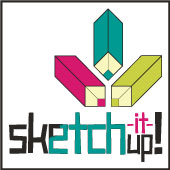GameSketching (Sketch-It-up!)

Sketch It Up! a student pitched project from Carnegie Mellon's Entertainment Technology Center. The project aimed to continue the previous game sketching investigation projects that Dr. John Buchanan, and his previous teams did.
Game sketching is a novel way to think about game development. In an industry where you need demonstrable results and prototypes in order to get funding, getting your idea across the table is more important than ever. Technical demos and prototypes usually tend to focus on look and feel or a specific implementation of a technology, but seldom they focus on gameplay. Game sketching tries to improve this by proposing a set of methodologies and tools designed to "sketch" a game and play it as early as possible.
During my first semester at Carnegie Mellon, I had to use the current game sketching tool as part of the development process for my Building Virtual Worlds class. During this time it gave me an idea of the current limitations of the system and what could be done to improve it.
I co-lead the pitch to CMU faculty, together with CMU alumnus Manoj Anand, since John Buchanan introduced us to the software and methodologies during our first semester. During the semester I co-designed and developed a new user interface, and participated in the daily team activities.
Features
The following feature list was the centre of our pitch:
- Sketch genres different than linear narratives
- Create a friendlier version of the current tool
- Gather feedback from CMU students, faculty and game industry professionals during our development cycles.
Here is a 30 second video showcasing our work:
Challenges
The project was challenging due to the following issues
One of the limitations I observed during my initial semester with game sketching was that the current tool was not easy to use and it had a steep learning curve. During the semester I co-designed the new interface with Theyab Al-Tamimi, our resident artist and implemented several UI enhancements:
- Mouse highlighting over objects
- Drag and drop 3D objects to the workspace.
- UI based transformation using the mouse: Rotation, Scale and translation of 3D objects
- Menu Bar
Sketching other genres different than linear narratives proved to be complex and ended up depending more on how well followed are the game sketching methodologies followed, than how friendly can the tool be.
An interesting side note is that game genres that depend on specific technologies or concepts can not be sketched using game sketching.The feedback gathered from CMU faculty was overall positive, although they were more interested in how to apply the tools to their own problems, than to learn more about the game sketching process. As part of exposing these tools to the industry we visited Schell Games in Pittsburgh, and Kaos studios in NYC. The developers at Kaos were very enthusiastic about it, and we had a lot of great feedback, specially from the game designers which meant that our tool effectively interested users across disciplines other than programmers.
Results
The team was extremely happy about the work done and so were the faculty at Carnegie Mellon. As part of our project, we did a submission as technical demo paper to the International Conference on Entertainment Computing, held for its 2009 version in Paris, France. We were there during one week, showcasing our findings and interchanging ideas with other Entertainment Computing investigators. Overall our project was praised for our pushing the boundaries of gamesketching and doing significant progress in the span of less than 15 weeks. Visit the Sketch-It-Up! website.